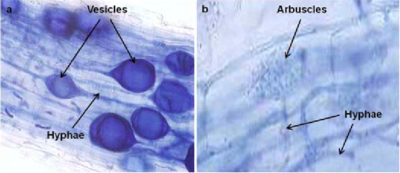The Underground Network: Arbuscular Mycorrhizal Fungi - Sebastian Jones: Difference between revisions
No edit summary |
No edit summary |
||
| Line 1: | Line 1: | ||
==Overview== | ==Overview== | ||
[[Image:AMF_microscope.png|thumb|400px|left|Image 1, microscope view of Arbuscular Mycorrhizal Fungi showing Vesicles, Hyphae and Arbuscles[<b>REF</b>].]] | [[Image:AMF_microscope.png|thumb|400px|left|Image 1, microscope view of Arbuscular Mycorrhizal Fungi showing Vesicles, Hyphae and Arbuscles[<b>REF</b>].]] | ||
Arbuscular Mycorrhizal Fungi (AMF) are a symbiotic fungi that colonize plant roots. They are identifiable by their unique structures vesicles, hyphae and arbuscles (Image 1). Arbuscular Mycorrhizal Fungi play many roles in an ecosystem. One of the most important roles of the AMF is the transfer of Phosphorous and Carbon between it and the host plant <b>REF</b>. In addition, they increase the resistance of their host to salinity and heavy metals <b>REF</b>, insects <b>REF</b>, droughts <b>REF</b>, and soil pathogens. They have also been shown to contribute to enhanced soil; Increasing soil structure, particularly in agricultural settings and preventing the loss of important nutrients due to rainfall <b>REF</b>. | Arbuscular Mycorrhizal Fungi (AMF) are a symbiotic fungi that colonize plant roots. They are identifiable by their unique structures vesicles, hyphae and arbuscles (Image 1). Three of the most common types of mycorrhizal symbioses are, ectomycorrhizal, endomycorrhizal and ecto-endomycrorizha. AMF's are the second, endomycorrhizal. Arbuscular Mycorrhizal Fungi play many roles in an ecosystem. One of the most important roles of the AMF is the transfer of Phosphorous and Carbon between it and the host plant <b>REF</b>. In addition, they increase the resistance of their host to salinity and heavy metals <b>REF</b>, insects <b>REF</b>, droughts <b>REF</b>, and soil pathogens. They have also been shown to contribute to enhanced soil; Increasing soil structure, particularly in agricultural settings and preventing the loss of important nutrients due to rainfall <b>REF</b>. | ||
| Line 7: | Line 7: | ||
==History== | ==History== | ||
The human history of understanding Arbuscular Mycorrhizal Fungi began in 1840 when Robert Hartig when he thought he was describing a root parasite, however, paleobotanical, morphological and phylogenetic data show that more than 400 million years, plants and AMF have coevolved <b>REF11</b>. Then in 1885, | The human history of understanding Arbuscular Mycorrhizal Fungi began in 1840 when Robert Hartig when he thought he was describing a root parasite, however, paleobotanical, morphological and phylogenetic data show that more than 400 million years, plants and AMF have coevolved <b>REF11</b>. Then in 1885, Albert Bernard Frank was the first to conceptualize it. | ||
==Genetics== | ==Genetics== | ||
Include some current research, with at least one image.<br><br> | Include some current research, with at least one image.<br><br> | ||
Revision as of 03:14, 7 December 2022
Overview
Arbuscular Mycorrhizal Fungi (AMF) are a symbiotic fungi that colonize plant roots. They are identifiable by their unique structures vesicles, hyphae and arbuscles (Image 1). Three of the most common types of mycorrhizal symbioses are, ectomycorrhizal, endomycorrhizal and ecto-endomycrorizha. AMF's are the second, endomycorrhizal. Arbuscular Mycorrhizal Fungi play many roles in an ecosystem. One of the most important roles of the AMF is the transfer of Phosphorous and Carbon between it and the host plant REF. In addition, they increase the resistance of their host to salinity and heavy metals REF, insects REF, droughts REF, and soil pathogens. They have also been shown to contribute to enhanced soil; Increasing soil structure, particularly in agricultural settings and preventing the loss of important nutrients due to rainfall REF.
History
The human history of understanding Arbuscular Mycorrhizal Fungi began in 1840 when Robert Hartig when he thought he was describing a root parasite, however, paleobotanical, morphological and phylogenetic data show that more than 400 million years, plants and AMF have coevolved REF11. Then in 1885, Albert Bernard Frank was the first to conceptualize it.
Genetics
Include some current research, with at least one image.
Sample citations: [1]
[2]
A citation code consists of a hyperlinked reference within "ref" begin and end codes.
For multiple use of the same inline citation or footnote, you can use the named references feature, choosing a name to identify the inline citation, and typing [4]
Second citation of Ref 1: [1]
Microbiome
Include some current research, with a second image.
Conclusion
Overall text length (all text sections) should be at least 1,000 words (before counting references), with at least 2 images.
Include at least 5 references under References section.
References
- ↑ 1.0 1.1 Hodgkin, J. and Partridge, F.A. "Caenorhabditis elegans meets microsporidia: the nematode killers from Paris." 2008. PLoS Biology 6:2634-2637.
- ↑ Bartlett et al.: Oncolytic viruses as therapeutic cancer vaccines. Molecular Cancer 2013 12:103.
- ↑ Lee G, Low RI, Amsterdam EA, Demaria AN, Huber PW, Mason DT. Hemodynamic effects of morphine and nalbuphine in acute myocardial infarction. Clinical Pharmacology & Therapeutics. 1981 May;29(5):576-81.
- ↑ 4.0 4.1 text of the citation
Edited by [Sebastian Jones], student of Joan Slonczewski for BIOL 116 Information in Living Systems, 2022, Kenyon College.

